Cargando...
Recursos educativos
-
Nivel educativo
-
Competencias
-
Tipología
-
Idioma
-
Tipo de medio
-
Tipo de actividad
-
Destinatarios
-
Tipo de audiencia
-
Creador
Lo más buscado
- Actividades con números naturales para secundaria
- Siglo XVIII
- Conjugador de verbos en gallego
- Letra ll
- Juegos para pintar educación primaria
- Experimentos
- Cine para educación secundaria
- cuerpos geométricos
- Arte gótico para primero
- Dibujos de experimentos
- Haber y hacer
- Ahorrar agua
- ejercicios matemáticas primaria
- Ejemplos de descripción literaria
- Instrumentos musicales educación primaria
-

Què és un climograma?
EduBook Organización
- 2505 visitas
Un climograma és un gràfic que representa les dades de temperatures mitjanes i de precipitacions totals que s'han enregistrat en un lloc concret durant un període de temps, normalment un any.…
-

Veritable/fals. Catalunya, una Comunitat Autònoma
EduBook Organización
- 2510 visitas
Indica si són veritables o falses aquestes afirmacions: El territori espanyol està dividit en 15 comunitats autònomes. La Junta de Catalunya és la institució encarregada d'organitzar el govern…
-

Aprèn. Elaborar un eix cronològic
EduBook Organización
- 2505 visitas
Material Paper quadriculat Llapis de colors Procediment Un eix cronològic és la representació gràfica dels fets històrics que han tingut lloc en el temps. Per elaborar un eix de les etapes de la…
-

Veritable/fals. Característiques principals dels ibers
EduBook Organización
- 2501 visitas
Indica si les afirmacions següents sobre els ibers són veritables o falses: Els ibers vivien al litoral mediterrani i al sud peninsular. Els ibers es dedicaven a la caça i a la recol·lecció. Els…
-

Contesta. El desenvolupament de l'embrió
EduBook Organización
- 2501 visitas
Recorda el que has treballat en aquest apartat i contesta: Explica quines diferències hi ha entre un zigot i un ou. I entre un zigot i un embrió? Quines funcions tenen els ous? Pots explicar per què…
-

True/false. The location of Spain.
EduBook Organización
- 2508 visitas
Decide if the following statements are true or false: Europe is located in the Northern Hemisphere. ➝ The Iberian Peninsula is located in the north-east of Europe. ➝ The Iberian Peninsula is joined…
-

The Palaeolithic period
EduBook Organización
- 2498 visitas
The first humans The Palaeolithic period is the first period in Prehistory. The Palaeolithic period began more than two million years ago. Human remains from the Palaeolithic period have been found in…
-

Introduction - Human reproduction
EduBook Organización
- 2505 visitas
Reproduction is an essential function in human beings. It enables humans to produce individuals similar to themselves. In this unit you will learn how the reproduction that started your life occurred.…
-

Look and answer. The salmon
EduBook Organización
- 2510 visitas
Look at the close-up of the salmon ova and sperm. Then answer the questions below. Where does fertilisation take place? Is it external or internal in salmon? What do the ova and sperm look like? How do…
-

True/false. Oviparous animals and viviparous animals
EduBook Organización
- 2506 visitas
Decide if the following statements are true or false: The time the embryo stays inside the mother is called gestation. ➝ The embryos of oviparous animals develop inside the mother. ➝ Mammals are…
Te estamos redirigiendo a la ficha del libro...













